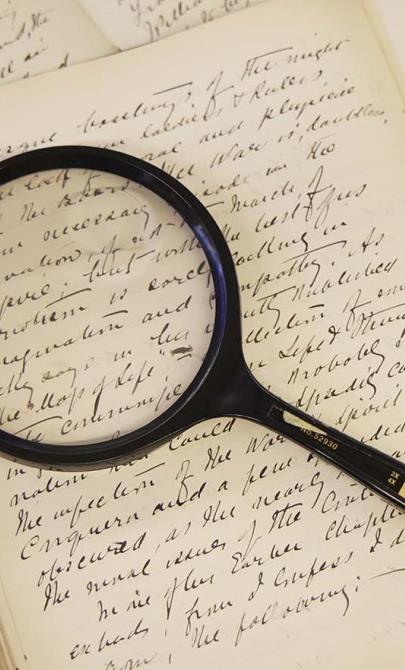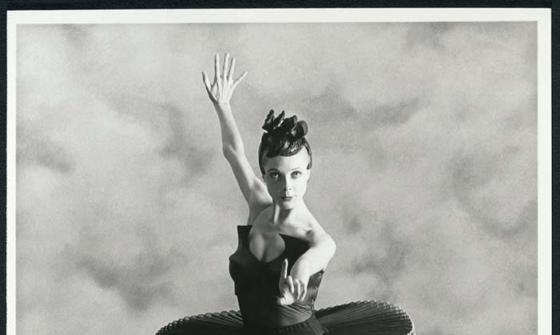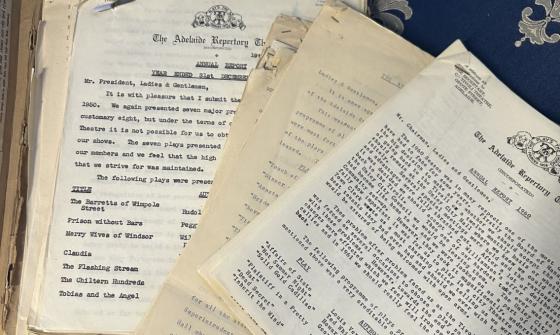Ingram Collection
Key items in the collection
Highlights from this collection demonstrate its historical significance and variety.
The manuscripts in the Geoffrey Ingram Collection primarily document the lives and work of Edouard and Xenia Borovansky, spanning 1918—Xenia Smirnoff’s birth in Russia—to around 1980. They include:
- Personal documents and letters
- Diaries and notebooks
- Photographs
- Music scores
- Contracts and financial papers
- Newspaper cuttings and programs
- Files on the Borovansky Ballet Academy, the Australian Academy of Dancing, and the Australian Ballet
Correspondents include:
- Peggy Van Praagh
- Elaine Fifield
- Tamara Tchinarova
- Leon Kelleway
- Laurel Martyn
- Frederick Ashton
- Margot Fonteyn
- Frank Tait.
The collection also contains some papers of Lisbeth Montgomerie, including a scrapbook, photographs, programs, and a cutting book documenting the Ballet Rambert’s visit to Australia in 1947–48.
The collection contains paintings, drawings and sketches by Edouard Borovansky. They comprise of:
- an oil self-portrait (1948)
- oil portraits of Xenia Borovansky and Edna Busse
- drawings of Serge Grigorieff
- Paul Petroff
- Mi Ladre
- David Lichina
- Irena Baranova
- 47 sketch drawings.
There are also some original costume designs.
Apart from photographs filed with manuscripts, the collection contains about 960 photographs of productions and of dancers, producers and other individuals associated with ballet companies. They are kept in albums and arranged in six series:
- Edouard Borovansky
- Anna Pavlova
- Ballets Russes, 1936–40
- Borovansky Ballet
- Ballet Rambert tour of Australia, 1947–48
- Australian Ballet
- Geoffrey Ingram
There are also family photographs.
The printed component of the Geoffrey Ingram Collection consists of:
- about 650 programs
- cast lists
- souvenir booklets
- issues of periodicals
- handbills
- invitations
- ephemera.
The bulk of the programs are of productions of the Borovansky Ballet (1941–57) and there are also programs of the De Basil Company, the Kirsova Company and the Australian Ballet.
Personal papers of Geoffrey Ingram include:
- documents
- correspondence
- contracts
- appointment diaries
- notebooks
- drafts of articles
- papers on the formation and early years of the Australian Ballet
- papers on the challenge to the SALT II Treaty
- writings on world peace
- the Mabo Case and other political subjects
- newspaper cuttings and printed material.
Correspondents include:
- Sir Robert Helpmann
- Peggy Van Praagh
- Will Thompson
- Leo McKern
- Sir Geoffrey Keynes
- Bishop Oliver Hayward.
About Geoffrey Ingram
Geoffrey Ingram (1924–2003) was born in Melbourne and educated at Middle Park Central School and Melbourne High School. He was a juvenile actor, appearing in plays and serials on commercial and national radio. He studied ballet with Xenia Borovansky and Eunice Weston, and later trained in London and Paris. On his return to Australia, he joined the Borovansky Company and later danced with Laurel Martyn’s Melbourne Ballet Company.
Contribution to the Australian Ballet
In 1958, Ingram collaborated with Margaret Scott to form a committee promoting a non-commercial national ballet company. He participated in meetings between the Australian Elizabethan Theatre Trust and J.C. Williamson that led to the establishment of the Australian Ballet Foundation. He subsequently advised the Foundation on trips to Paris, Moscow, and Leningrad, and worked with Peggy Van Praagh in London. Ingram launched the education and promotion programs of the Australian Ballet for its inaugural season in 1962, served as administrator from 1963 to 1965, and organised its first overseas tour featuring guest artists Margot Fonteyn and Rudolf Nureyev.
Later activities
Ingram later moved into film production and owned a restaurant. He was actively involved in public affairs, including a 1969 High Court action challenging the legality of the SALT II Treaty. In his later years, he became involved in the National Dance Research Centre.
Archival work
In 1985, Ingram inherited the personal archives of Russian-born dancer and teacher Xenia Borovansky (1903–1985) and her husband, dancer and ballet director Edouard Borovansky (1902–1959). He also obtained materials from other sources, notably Lisbeth Montgomerie, who had been secretary to the Borovanskys.
Background to the collection
The original Geoffrey Ingram Collection was purchased from Ingram in 1987. Additional manuscripts and personal papers were bought in 1994. In 2003, shortly before his death, Ingram sold his remaining papers to the Library.
The manuscripts and personal papers are kept together in the Manuscripts collection. Use the finding aid.
The paintings, drawings and figure studies are held in the Pictures collection.
The photographs are also held in the Pictures Collection. A 16-page finding aid is also available.
The programs and other printed ephemera in the original Geoffrey Ingram Collection are housed in the Australian performing arts collection (PROMPT).
This guide was prepared using these references:
- Obituary of Geoffrey Ingram, Herald Sun, 4 July 2003, p. 96.
- Michelle Potter, Oral history interview with Geoffrey Ingram, 1988, ORAL TRC 2372.
- Michelle Potter, The Geoffrey Ingram Archive of Australian Ballet, National Library of Australia News, vol. 3 (12), September 1993, pp. 11–13.
- Frank Salter, Borovansky, The Man Who Made Australian Ballet, Wildcat Press, Sydney, 1980.







